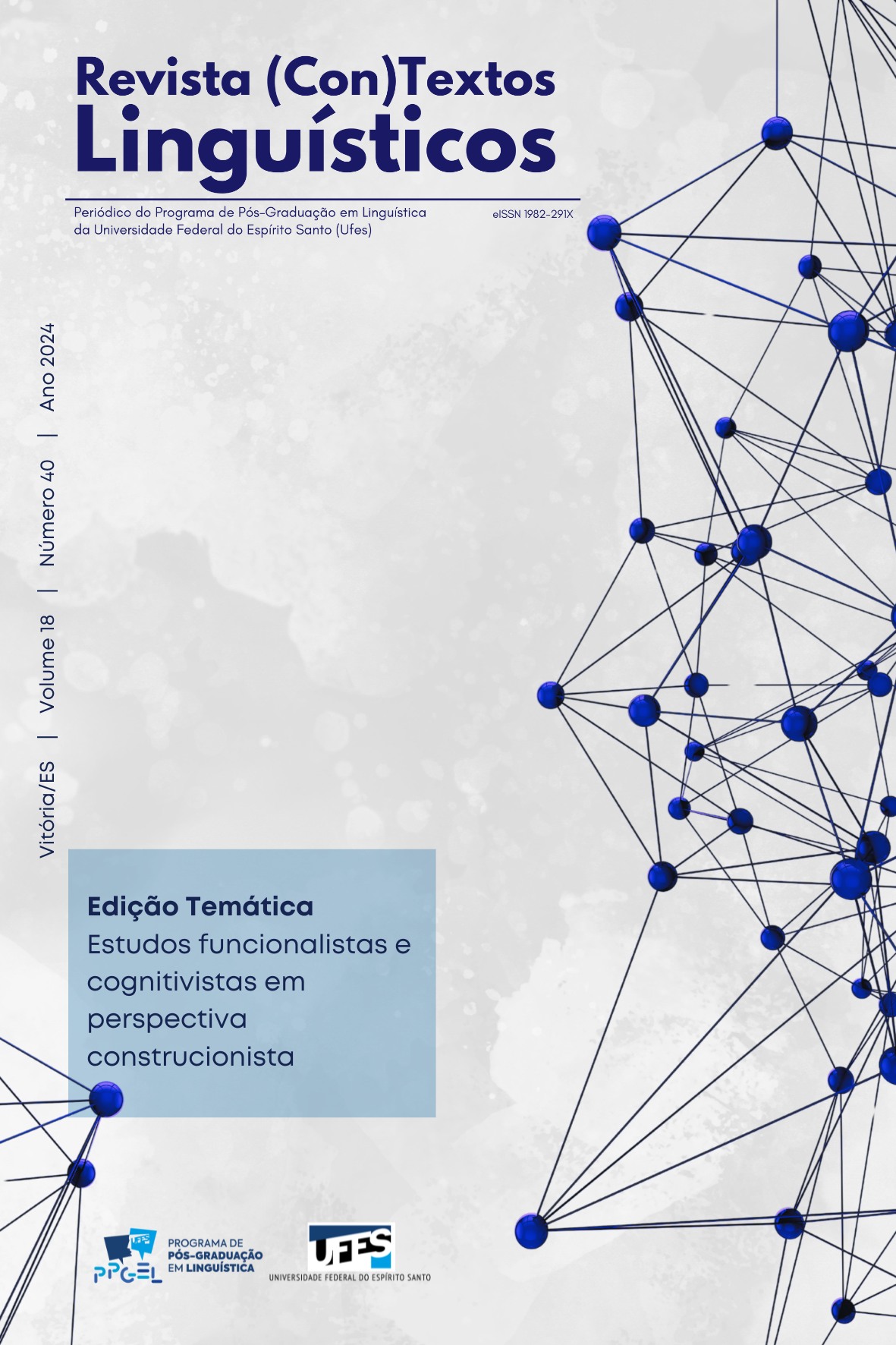Idiomaticidade na gramática
uma abordagem construcionista dos padrões idiomáticos com “VÊ/VEJA SE S” no português brasileiro
DOI:
https://doi.org/10.47456/rctl.v18i40.45048Palabras clave:
Construções idiomáticas, Construção de Repreensão Preventiva, Construção de Busca de CorroboraçãoResumen
Este artigo busca descrever duas construções idiomáticas com VÊ/VEJA SE S (ilustradas por enunciados como “Vê se me devolve meu livro” e “Veja se meio-dia é hora de acordar”) no português brasileiro contemporâneo, tomando como base o arcabouço teórico da Gramática de Construções Baseada no Uso. Do ponto de vista metodológico, recorremos a uma análise quantitativa e qualitativo-interpretativa de dados extraídos do Corpus do Português. Em síntese, o que os dados demonstram é que essas construções idiomáticas são especializadas, respectivamente, na função de dirigir uma repreensão preventiva ao interlocutor e buscar a corroboração do interlocutor. Mais especificamente, a primeira construção expressa um comando para a realização de uma ação que, sob a perspectiva do falante, o interlocutor já sabia que deveria realizar. Já a segunda é usada para convidar o interlocutor a corroborar uma posição de discordância em relação a uma crença atribuída a um dado Sujeito de Consciência. A partir dessa análise, foi possível postular, ainda, a existência de uma construção mais abstrata que, do ponto de vista da forma, exibe a sequência VÊ/VEJA SE S e, do ponto de vista do significado, preserva a semântica de avaliação negativa.
Descargas
Referencias
ALVES, D. O.; PINHEIRO, D. O. R.; LEITE DE OLIVEIRA, D. “Vê se lê este artigo”: o surgimento de uma construção idiomática com VÊ/VEJA SE S no português brasileiro. Revista LinguíStica, Rio de Janeiro, v. 19, n. 1, p. 303-323, 2023.
ALVES, D. O.; PINHEIRO, D. O. R. Analogização e o surgimento de uma nova construção idiomática com VÊ/VEJA SE S no português brasileiro. Estudos Linguísticos e Literários, Salvador, no prelo.
ANDRADE, C. Q.; MELO, F. G. de; SCHERRE, M. M. P. História e variação lingüística: um estudo em tempo real do imperativo gramatical em revistas em quadrinhos da Turma da Mônica. Finos Leitores: Jornal de Letras, Brasília, v. 3, n. 1, 2007.
AUSTIN, J. L. How to do things with words. Oxford: Oxford University Press, 1962.
BROWN, P.; LEVINSON, S. Politeness: some universals of language usage. Cambridge: Cambridge University Press, 1987.
BYBEE, J. Usage-based grammar and second language acquisition. In: ELLIS, N. C.; ROBINSON, P. (eds.). Handbook of Cognitive Linguistics and Second Language Acquisition. London: Routledge, 2008. p. 216-236.
BYBEE, J. Language, usage and cognition. Cambridge: United Kingdom University Press, 2010.
CUNHA, C.; CINTRA, L. Nova gramática do português contemporâneo. 5. ed. Rio de Janeiro: Lexikon, 2013.
FILLMORE, C. Syntatic Intrusions and The Notion of Grammatical Construction. Proceedings of the 11th Annual Meeting of the Berkeley Linguistics Society, 1985. p. 73-86.
FILLMORE, C.; KAY, P.; O’CONNOR, C. Regularity and Idiomaticity in Grammatical Constructions: The Case of Let Alone. Language, n. 64, p. 501-538, 1988.
GOLDBERG, A. A construction grammar approach to argument structure. Chicago: University of Chicago Press, 1995.
GOLDBERG, A. Constructions at Work: The Nature of Generalization in Language. Oxford: Oxford University Press, 2006.
HILPERT, Martin. Construction Grammar and Its Application to English. Edinburgh: Edinburgh University Press, 2014.
LAKOFF, G. Women, fire and dangerous things: what categories reveal about mind. Chicago: University Chicago Press, 1987.
LAMBRECHT, K. Information structure and sentence form: A theory of topic, focus, and the mental representations of discourse referents. Cambridge: Cambridge University Press, Cambridge Studies in Linguistics, vol. 71, 1994.
LANGACKER, R. Foundations of Cognitive Grammar, vol. 2, Descriptive Application. California: Stanford University Press, 1991.
MAAT, H. P.; SANDERS, T. Subjectivity in causal connectives: An empirical study of language in use. Cognitive Linguistics, v. 12, n. 3, p. 247-273, 2001.
PEREK, F. Argument Structure in Usage-based Construction Grammar: Experimental and Corpus-based Perspectives. Amsterdam: John Benjamins Publishing Company, 2015.
SANDERS, J.; SANDERS, T.; SWEETSER, E. Causality, cognition and communication: A mental spaces analysis of subjectivity in causal connectives. Discourse Processes, v. 45, n. 1, p. 1-22, 2009.
SANDERS, T.; SWEETSER, E. Causal categories in discourse and cognition: Sources of coherence in text and mind. Discourse Studies, v. 14, n. 3, p. 209-228, 2012.
SCHERRE, M. M. P. Aspectos sincrônicos e diacrônicos do imperativo gramatical no português brasileiro. Alfa, v. 51, n. 1, p. 189-222, 2007.
SEARLE, J. Expression and meaning: studies in the Theory of Speech Acts. New York: Cambridge University Press, 1979.
TANTUCCI, V. From co-actionality to extended intersubjectivity: Drawing on language change and ontogenetic development. Applied Linguistics, v. 41, n. 2, p. 185-214, 2020.
TANTUCCI, V. Language and social minds: The semantics and pragmatics of intersubjectivity. Cambridge: Cambridge University Press, 2021.
TRAUGOTT, E.; DASHER, R. Regularity in semantic change. Cambridge: Cambridge University Press, 2002.
TRAUGOTT, E.; TROUSDALE, G. Constructionalization and constructional changes. New York: Oxford University Press, 2013.
VERHAGEN, A. Constructions of Intersubjectivity: Discourse, Syntax and Cognition. Oxford: Oxford University Press, 2005.
Descargas
Publicado
Número
Sección
Licencia
Derechos de autor 2024 Revista (Con)Textos Linguísticos

Esta obra está bajo una licencia internacional Creative Commons Atribución-NoComercial 4.0.
Los autores ceden los derechos de autor del artículo a la editorial de la Revista (Con)Textos Linguísticos (Programa de Posgrado en Lingüística de la Ufes), si el envío es aceptado para publicación. La responsabilidad por el contenido de los artículos recae exclusivamente en sus autores. Queda prohibido el envío total o parcial del texto ya publicado en la revista a cualquier otro periódico.
Este trabajo está bajo Creative Commons Attribution-NonCommercial 4.0 International License.



